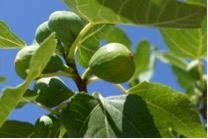Fig
-
Scientific NameFicus carica
-
General InformationFig trees are deciduous, easily-grown, and don't require pollination to yield fruit. Most bear two crops per year: early summer and late summer/early fall. Native to western Asia and eastern Mediterranean, figs thrive in warm climates but also grow in more temperate areas. Franciscan missionaries planted the first figs in 1769 in San Diego.
 Photo: Dgazdik, pixabay
Photo: Dgazdik, pixabay -
When to Plant
Fig trees are best planted in the spring or late fall. They are grown on their own roots from cuttings or rooted side shoots.
-
Planting
Fig trees are sold bare root or in containers. They should be planted where they will receive full sun for least eight hours per day during the growing season. Plant where protected from wind. Site selection is important since many fig trees can reach a height of 20 to 30 feet with an equal spread. However, the tree can be pruned to maintain a smaller size.
Fig trees put down deep roots if given the chance so bear this in mind when selecting a planting spot.
To plant a container-grown tree, remove the plant from the pot and cut off any circling roots. Container grown figs need special attention with fertilization and irrigation.
Learn more about planting bare root trees.
-
Soil Requirements
Fig trees will grow in many soil types. Make sure the soil is well drained, contains plenty of organic material, and is free of root-knot nematodes.
-
Water Requirements
Young fig trees require regular water to help them become established. On established trees, the amount and frequency of watering depends upon the size of the tree, soil type, and soil depth. Clay soils need less frequent irrigation, but require larger amounts of water to wet the soil deeply. Trees growing in shallow soils should be watered more often than those on deep soils.
-
Fertilizing
When first planting a fig tree, add a top dressing of compost.
The second year, add compost around the base of the tree (away from the trunk) in the spring. Well-established trees need light to moderate fertilizer, mainly nitrogen. If your fig tree is not growing at least 12 inches annually, add organic nitrogen. Apply five to seven pounds of rabbit or poultry manure per year. Alternatively, use other organic amendments available at the nursery such as blood meal or alpha meal. Follow directions on the container.
-
Pollination
Flowers of the common fig tree do not require pollination to yield figs. If you look for blossoms on your fig tree, you won’t find any because they are inside the fruit. There are over 700 varieties of figs, many of which do not produce edible figs or have very specific pollination requirements (e.g. needing to be pollinated by a certain type of wasp). This makes those varieties undesirable for the home gardener.
-
Harvesting
Varieties of figs that produce edible fruit usually produce one to two crops per year. The first ("breba" crop) comes in early summer on last year’s wood. The second comes in late summer or early fall from the current year’s growth. Fresh figs must be hand-picked. However, most commercially sold figs are harvested as a dried crop. The fruit is allowed to dry on the tree and fall to the ground. The figs are then mechanically swept into windrows and collected, fumigated, and sun dried or dehydrated. California produces 100% of domestic dried figs.
-
Storage
Once fresh figs are harvested, they should be consumed in a matter of days. Dried figs can be stored in containers in a cool, dark place for an extended period.
-
Good Varieties for Marin
'Desert King': Green-skinned, red-fleshed fruit. Adaptable to all fig climates but better in cooler areas. Bears one late summer crop.
'Improved Brown Turkey': Brownish purple fruit. Adaptable to most fig growing climates. Good, small garden tree.
'Black Mission': Purple-black figs with pink flesh. Good fresh or dried. Widely adapted. Popular in California.
'Osborne Prolific': Dark reddish-brown skin; amber flesh. Very sweet; best eaten fresh. Best in Northern California coastal areas.
-
Helpful Tips
Control gophers.
Pruning: To protect from disease, do not prune figs in summer. Only prune in winter. Learn how to prune fig trees:
• Black (e.g. Mission)
• White and brown (e.g., Kadota, Thompson)Seasonal Care:
Winter: remove dead, diseased or broken branches. Prune to shape.
Spring and summer: Thinning of fruit is generally not required. If two fruit grow from one bud, remove one of the “twins.” Limit fruit to seven on each branch.
Dry season: Irrigate regularly, approximately every week. Amount depends on soil type, size of tree, and phase of fruit development. Young trees may need three to five gallons of water per week. Water deeply and at drip line.
-
Common Problems
Gophers.
-
Pests- Diseases & More
Fig Beetle (Cotinis texana): Damage is done by the adults scraping a hole in the fruit and feeding on the flesh inside. Their excrement stains the skin of the fruit.
Fig Mite (Aceria fici: The fig mite infests bud scales and young leaves. Feeding causes a faint russeting of the leaves, generally in the interior portion of the canopy, and may result in leaf drop and stunting of twigs.
Pocket gophers can injure or kill a tree by feeding on the roots.

